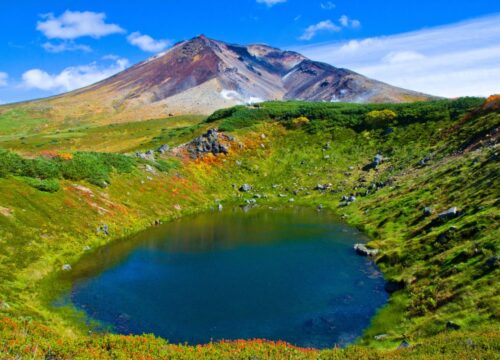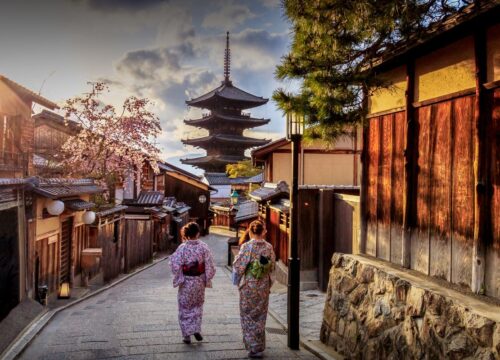Discover the Land of the Thundar Dragon
Explore The Worlds!
Description
Who is it for?
Travel pioneers who want to experience culture and beauty very few have ever had the privilege of exploring.
What is it?
Designed to provide a legitimate glimpse into Bhutanese life and culture, this 6-day itinerary centres on cultural experiences – such as monastery and Dzong explorations, visits to local farmhouses, textiles, and markets – and exceptional hikes. This Himalayan kingdom is only open to a limited number of visitors every year, making it one of the more exclusive destination on Earth.
Highlights: Views of the Himalayan Mountains, hike to Tiger’s Nest in Paro and other day hikes, visit a local Farmhouse, visit monastery and some museums, shopping, cultural show
Season: March to October
Included/Excluded
Tour Amenities
Tour Duration
Duration
Starting Price
From
Contact Us for pricing
Travel Style
Tour Type
Day by Day Itinerary
Arrive at Paro Airport and then drive to the capital city Thimphu. The flight into the Himalayas reveals scenic and breathtaking views of Himalayan Mountains of the world. If weather permits you will be able to see Mt Everest (8848m, 29,198ft) and other Himalayan mountain ranges. On the way to Thimpu visit the Tachhog Lhakhang temple. Check into the hotel.
Later visit visit the textile museum, the Memorial Chorten, and the Tashichho Dzong. The Bhutanese Dzongs are huge architectural structures constructed for a variety of functions throughout the country, from administrative buildings to monasteries and temples, yet they are carefully and thoughtfully designed and are strikingly beautiful. Then we will stop at the Sangaygang viewpoint for some breathtaking views.
Overnight in Thimphu. (D)
Morning take a hike to Cheri Monastery (about 1hrs to and fro). This monastery was built in 1620 and established the first monk body here. Also a chance to spot birds such as Mrs Gould’s Sunbird, Yellow-browed Tit, Yellow-rumped Honeyguide, Long-billed Thrush, Ultramarine Flycatcher.
Afterwars visit the General Post office of Bhutan: an opportunity to get an insight into Bhutan through its stamps. Visit their Philatelic Bureau for their beautiful, unique and wide range of stamps and philatelic products. Then onto the Bhutan Craft bazaar: The private stalls had a variety of high-end quality products from areas across the country. Then visit the Paper factory. Paper making in Bhutan stemmed from the age-old tradition that originated in 8th century. The handmade paper is seen as a valuable National heritage of Bhutanese culture.
Then visit the Thangtong Dewachen (Nunnery) and the Simtokha Dzong. The location of the Simtokha Dzong has great historical significance. The present place where the Dzong stands was the crossroads of the three prominent western regions of Sha (Wangduephodrang), Wang (Thimphu) and Pa (Paro). The Dzong was successfully completed in 1631 and named as “Sanga Zabdhoen Phodrang” (Palace of the Profound Meaning of Secret Mantras).
Finally visit the Zorig Chusum Institute: The 13 arts and Crafts institute. The two main objectives of the institute are a) to preserve and promote the traditional arts and crafts and b) to create job opportunities for the underprivileged group of the society.
Later stroll around the city and later dinner at typical Bhutanese restaurant with a cultural show. Overnight in Thimphu (B/L/D)
In the morning visit the weekend market – held every Friday, Saturday and Sunday, the people crowd the stalls every day, dressed in full colour and gathered to meet and to barter.
Then drive from Thimpu to Punakha/Wangdue (3 hour drive), crossing the Dochula Pass with a stunning panoramic view of the Himalayan mountain range. The beauty of this place is further enhanced by the Druk Wangyal Chortens – 108 stupas built by the eldest Queen, Her Majesty Ashi Dorji Wangmo Wangchuck.
Later visit the Punakha Dzong (fortress), built in 1637 and located between the rivers of Mo (Female) Chu (river) and Pho (Male) Chu. Until the time of second king it served as a seat of the king. Finally, hike to Chimi Lhakhang (Temple of fertility), which was built in 1499. Wooden phalluses are often found hanging in the four corners of the houses and painted on the walls of houses. It is the common belief that this helps in driving away evil spirits.
Overnight in Punakha/Wangdue. (B/L/D)
In the morning drive to Paro and visit Rimpung Dzong. The Rimpung Dzong, known as the “fortress of the heap of jewels”, is located in the picturesque setting of the Paro valley, built in the time of the dynamic spiritual and political leader Zhabdrung in 1644. Then visit the Kichu Lhakhang (Monastery), one of the two most sacred and the oldest temples in Bhutan. It was built in 7th century by the Tibetan King Songtsen Gampo.
Overnight in Paro. (B/L/D)
Morning hike to Taktshang Monastery (Tiger’s nest). This is Bhutan’s most recognizable cultural icon perched 800m/2640ft up a seemingly sheer cliff. Although it was tragically and mysteriously consumed by fire in April 1998 it has now been restored to its former glory. It is believed that in the 8th century, the great tantric master Guru Rimopche/ Padmasambhava (2nd Buddha) flew on the back of a tigress to the site where the monastery now stands. It is a three-hour hike to and from. There is also the option to ride a horse upward for an extra cost of US$25 per person.
Then visit a local Farmhouse. Picturesque farmhouses dot the valley amongst fields and hillsides. We welcome you to enjoy the hospitality of the Paro farmers. The two to three-storied Bhutanese farmhouses are handsome in appearance, with colorfully decorated outer walls and lintels, and are traditionally built. A visit to a farmhouse gives an interesting glimpse into the lifestyle of a farming family. (If you take a hot stone bath in the farmhouse it will cost extra US$25 per person.)
Later stroll around the town and see how locals live. Overnight in Paro. (B/L/D)
Explore Tours
Who is it for?
Travel pioneers who want to experience culture and beauty very few have ever had the privilege of exploring.
What is it?
Designed to provide a legitimate glimpse into Bhutanese life and culture, this 6-day itinerary centres on cultural experiences – such as monastery and Dzong explorations, visits to local farmhouses, textiles, and markets – and exceptional hikes. This Himalayan kingdom is only open to a limited number of visitors every year, making it one of the more exclusive destination on Earth.
Highlights: Views of the Himalayan Mountains, hike to Tiger’s Nest in Paro and other day hikes, visit a local Farmhouse, visit monastery and some museums, shopping, cultural show
Season: March to October
Included/Exclude
Tour Amenities
Tour Plan
Arrive at Paro Airport and then drive to the capital city Thimphu. The flight into the Himalayas reveals scenic and breathtaking views of Himalayan Mountains of the world. If weather permits you will be able to see Mt Everest (8848m, 29,198ft) and other Himalayan mountain ranges. On the way to Thimpu visit the Tachhog Lhakhang temple. Check into the hotel.
Later visit visit the textile museum, the Memorial Chorten, and the Tashichho Dzong. The Bhutanese Dzongs are huge architectural structures constructed for a variety of functions throughout the country, from administrative buildings to monasteries and temples, yet they are carefully and thoughtfully designed and are strikingly beautiful. Then we will stop at the Sangaygang viewpoint for some breathtaking views.
Overnight in Thimphu. (D)
Morning take a hike to Cheri Monastery (about 1hrs to and fro). This monastery was built in 1620 and established the first monk body here. Also a chance to spot birds such as Mrs Gould’s Sunbird, Yellow-browed Tit, Yellow-rumped Honeyguide, Long-billed Thrush, Ultramarine Flycatcher.
Afterwars visit the General Post office of Bhutan: an opportunity to get an insight into Bhutan through its stamps. Visit their Philatelic Bureau for their beautiful, unique and wide range of stamps and philatelic products. Then onto the Bhutan Craft bazaar: The private stalls had a variety of high-end quality products from areas across the country. Then visit the Paper factory. Paper making in Bhutan stemmed from the age-old tradition that originated in 8th century. The handmade paper is seen as a valuable National heritage of Bhutanese culture.
Then visit the Thangtong Dewachen (Nunnery) and the Simtokha Dzong. The location of the Simtokha Dzong has great historical significance. The present place where the Dzong stands was the crossroads of the three prominent western regions of Sha (Wangduephodrang), Wang (Thimphu) and Pa (Paro). The Dzong was successfully completed in 1631 and named as “Sanga Zabdhoen Phodrang” (Palace of the Profound Meaning of Secret Mantras).
Finally visit the Zorig Chusum Institute: The 13 arts and Crafts institute. The two main objectives of the institute are a) to preserve and promote the traditional arts and crafts and b) to create job opportunities for the underprivileged group of the society.
Later stroll around the city and later dinner at typical Bhutanese restaurant with a cultural show. Overnight in Thimphu (B/L/D)
In the morning visit the weekend market – held every Friday, Saturday and Sunday, the people crowd the stalls every day, dressed in full colour and gathered to meet and to barter.
Then drive from Thimpu to Punakha/Wangdue (3 hour drive), crossing the Dochula Pass with a stunning panoramic view of the Himalayan mountain range. The beauty of this place is further enhanced by the Druk Wangyal Chortens – 108 stupas built by the eldest Queen, Her Majesty Ashi Dorji Wangmo Wangchuck.
Later visit the Punakha Dzong (fortress), built in 1637 and located between the rivers of Mo (Female) Chu (river) and Pho (Male) Chu. Until the time of second king it served as a seat of the king. Finally, hike to Chimi Lhakhang (Temple of fertility), which was built in 1499. Wooden phalluses are often found hanging in the four corners of the houses and painted on the walls of houses. It is the common belief that this helps in driving away evil spirits.
Overnight in Punakha/Wangdue. (B/L/D)
In the morning drive to Paro and visit Rimpung Dzong. The Rimpung Dzong, known as the “fortress of the heap of jewels”, is located in the picturesque setting of the Paro valley, built in the time of the dynamic spiritual and political leader Zhabdrung in 1644. Then visit the Kichu Lhakhang (Monastery), one of the two most sacred and the oldest temples in Bhutan. It was built in 7th century by the Tibetan King Songtsen Gampo.
Overnight in Paro. (B/L/D)
Morning hike to Taktshang Monastery (Tiger’s nest). This is Bhutan’s most recognizable cultural icon perched 800m/2640ft up a seemingly sheer cliff. Although it was tragically and mysteriously consumed by fire in April 1998 it has now been restored to its former glory. It is believed that in the 8th century, the great tantric master Guru Rimopche/ Padmasambhava (2nd Buddha) flew on the back of a tigress to the site where the monastery now stands. It is a three-hour hike to and from. There is also the option to ride a horse upward for an extra cost of US$25 per person.
Then visit a local Farmhouse. Picturesque farmhouses dot the valley amongst fields and hillsides. We welcome you to enjoy the hospitality of the Paro farmers. The two to three-storied Bhutanese farmhouses are handsome in appearance, with colorfully decorated outer walls and lintels, and are traditionally built. A visit to a farmhouse gives an interesting glimpse into the lifestyle of a farming family. (If you take a hot stone bath in the farmhouse it will cost extra US$25 per person.)
Later stroll around the town and see how locals live. Overnight in Paro. (B/L/D)


